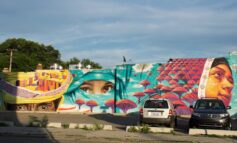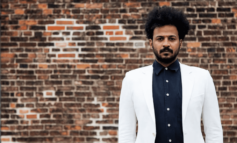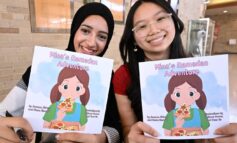The National Arab American Museum’s fourth annual gala, featuring the Egyptian national Um Kulthoum Orchestra, filled the Detroit Opera House a few weeks ago with more than 2,000 guests.
The museum’s third annual film festival the following weekend drew large audiences. And a new jewelry exhibit opens next week. These are busy times for the only museum in the country dedicated to Arab Americans. The Arab-American News caught up with its director, Dr. Anan Ameri, to talk about the state of the museum and where it is headed.
TAAN: How is the museum doing? Is it meeting its goals?
Dr. Ameri: The museum is doing very well considering it has been open for less than three years. At this stage, we’re trying to create it as a culture center. Traditionally, museums are places where you have beautiful things behind glass. That is not our understanding. A museum is a live place where people interact and talk. The programs are important activities that bring people together.
(The museum) is a pan-Arab institution, it is secular, it embraces Arabs of all backgrounds. As an ethnic museum, we really want to embrace our culture. It is about celebrating the diversity of America and embracing other cultures. We’re part of larger society.
TAAN: Please tell us about the outgoing exhibit, “Threads of Pride,” and the incoming one, “Silver Speaks.”
Dr. Ameri: The current exhibit, “Threads of Pride,” is about Palestinian embroidery. That region of the Arab world has very elaborate dresses, with very intricate embroidery. It is interesting because it is unique. It reflects Palestinian history. Before 1948, the clothing reflected the class. Rich families had more elaborate embroidery. If you were poor, you did your own embroidery. Rich people hired somebody to do it.
Also, each part of Palestine had its own distinct clothing. You could tell where a woman was from by her clothing. After 1948, you see a shift. With the occupation and creation of the state of Israel, embroidery from the coastal areas disappeared. It stayed in the West Bank and Gaza; for some women it became a way of making a living. There was a lot of hardship involved in keeping the tradition of embroidery; but people kept it as an expression of their cultural heritage and perseverance. Organizations also contributed to maintaining this tradition. In a way Palestinian embroidery came to symbolize Palestinian cultural heritage and national identity.
The jewelry exhibit is also about Arab culture, with a focus on Yemen and the Gulf area. Jewelry was very elaborate and a beautiful art. It showed the wealth and status of a woman. We brought it to show different aspects of Arab culture.
The museum’s focus is on Arab Americans, but we like to showcase Arab culture, as well. There are a lot of women in the area who have antique jewelry, some a hundred years old for example. People acquire it to express their cultural heritage. With the Yemeni population, this should appeal to a new audience. And, it will appeal to women who like jewelry, as well.
These exhibits are costly and take a lot of work. They last for 2 to 3 months usually.
TAAN: How did this year’s gala go?
Dr. Ameri: It was the most magnificent event the Arab American community has had in a long time. It is our annual fundraiser so we raised money. But, what made it different was that it is the first time the Detroit Opera House had an Arab event. We had over 2000 people.
The price ranged between five hundred dollars, if you wanted to be a supporter, and twenty-five dollars for students and low-income individuals. People could bring their whole family.
The music was absolutely fantastic. I have never heard better music than this group. The museum organized a national tour for them, so we had the opportunity to work with other Arab American organizations around the country.
They came from Egypt, they are the national orchestra. We worked with the Egyptian embassy on this.
TAAN: What about more regular programming, such as Global Thursdays, which brings performers to the museum each week?
Dr. Ameri: Don’t forget our third film festival, which was amazing. It just ended. We had to bring chairs into the auditorium. It was packed.
With Global Thursdays, we respect and reflect the diversity of our nation. If we want others to celebrate Arab culture, we have to celebrate other cultures. It is not just about us. Through the arts, we can bridge so many of the lines that divide our communities.
The idea is to bring music from different cultures for different audiences. It is our way to work with the Arab community, to extend our hand to other communities. We are saying, the museum welcomes you and your artistic expression.
This is the same with the Concert of Colors, the largest world music festival in the country. It is free and we do it every year. We have it at the Detroit Symphony Orchestra.
It is important for ACCESS and the Museum to understand the needs of the Arab American community, especially recent immigrants and low-income families, and the need of Arab Americans to celebrate their culture and heritage. But also, other communities have similar needs and we can only work together if we are respectful of each other. We are the Arab American Museum but there is no reason we cannot have Bulgarian music. It is good to be exposed to other cultures.
TAAN: What is the museum’s future direction?
Dr. Ameri: We think of the first five years as the founding years. Our main goal is to institutionalize the museum so these programs happen every year and are consistent. We need to make sure the staff is professional and know what they are doing because it is a new institution.
We want to secure the funding. It is a tough economy and we have to make what we can from it. It is not funded by the government, it is funded by us. Our goal is to build the endowment, which now has $3 million. Few Arab American organizations have endowments, so it is very important to build it.
Also, we have a library that specializes in Arab America. We want to build it so people who need information about Arab Americans can get it.
We want to establish regional committees around the country where our programs can spread. For example, the Um Kulthoum Orchestra traveled, as do exhibits. Our museum has a regional and national impact.
We would love if other Arab American communities looked at us and said “if they can do it, so can we.” Building a museum is not rocket science. It is only a matter of commitment, imagination, hard work and integrity. We are lucky to have ACCESS. It is thirty-five years old, it is respected, it has a national scope. That helps us but we hope other communities start looking at the possibility. There are 60 Jewish museums and 200 African American museums, there is no reason we only have one. Our plan is not to build anything outside, but we hope to encourage others to start seeing the need.
Every year, we get 50,000 visitors, half of them are students. So you can see the cumulative impact over the years. The museum attracts them, and schools are making it part of their curriculum. The museum is an educational institution.





Leave a Reply